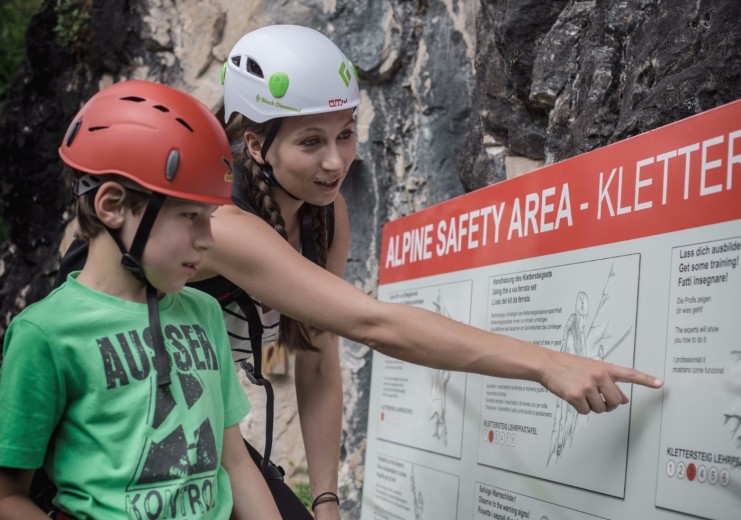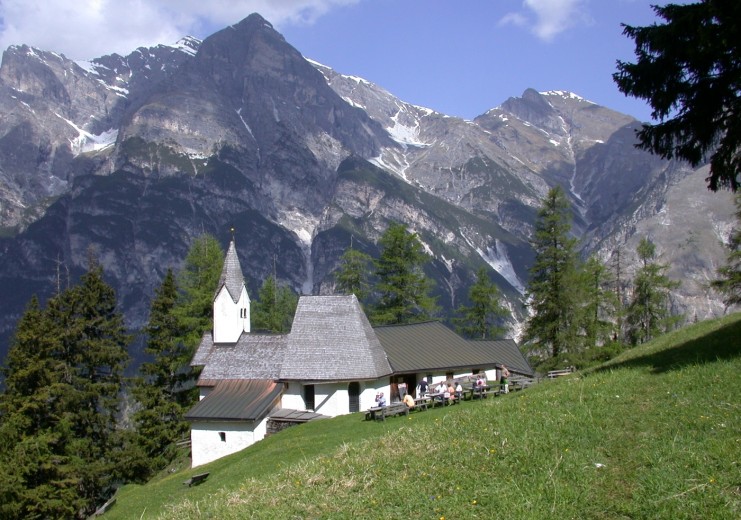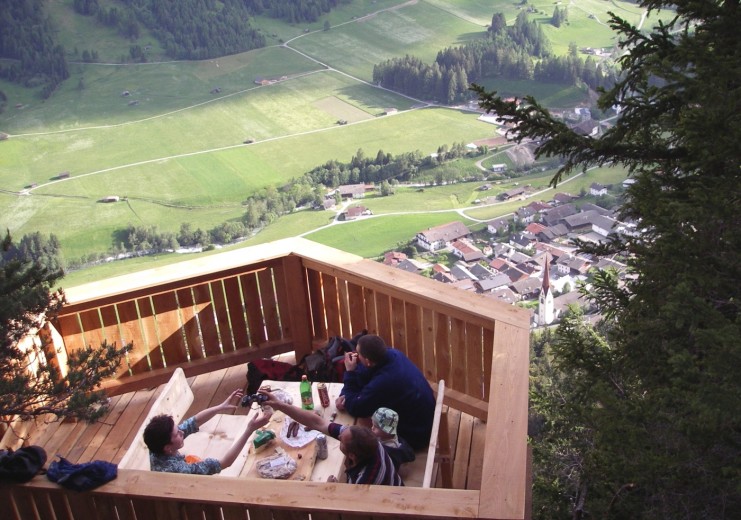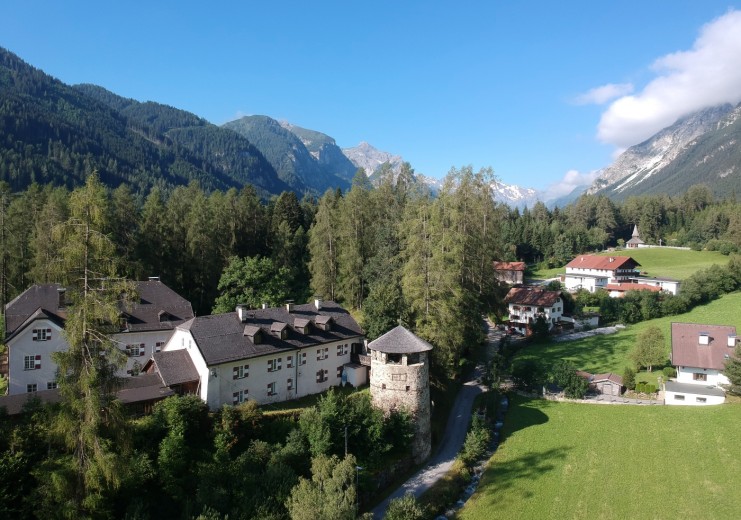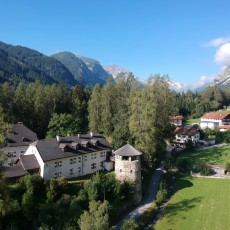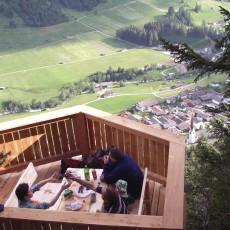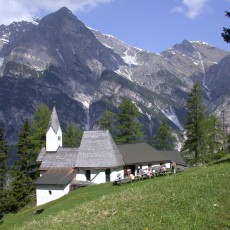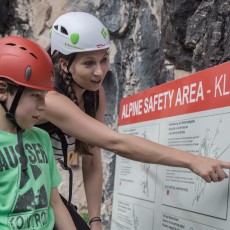Schneeberg Castle
Schneeberg Castle is situated on the valley floor in Trins. It is not until after the year 1500 that we can find reliable information about the castle, when the Imperial Councillor Franz Schneeberger received the castle as a fief from Emperor Maximilian. However, as early as 1518 a report was sent to the government regarding the desolate state of the castle, so we can assume that the castle must have been there for quite some time. A number of fief owners followed between 1568 and 1636. It was not until 1636 that the Barons of Schneeberg were the owners once again. Following their demise in 1778, Empress Maria Theresia handed the castle over to the Councillor Alois Count Sarnthein. The present appearance of the castle has been shaped by the many renovations carried out since then. Some rooms have been restored with attention to detail and it has been possible to rent private rooms there for some years now. The Trins coat of arms symbolises the battlements of Schneeberg Castle on the moraine wall.
Moraine wall
The mountains south of Trins are made up of very old Paleozoic rocks from the Carboniferous period: sandstones and conglomerates in which fossilised ferns, horsetails and lycopodae can be found. These species grew 300 million years ago in extensive marshlands. These plants were fossilised and transformed into coal over millions of years.
The most recent geological past, the Ice Age, has also left many traces here. The striking end moraine wall impressed the natural scientists because of its perfect preservation to such an extent that it was included in specialist literature as a Late Ice Age type locality, as the “Gschnitz stage”. This glacier advance took place during the last ice age (“Würm”) that was coming to an end approx. 13,500 years ago. Back then the glaciers, brought about by a cold period, once again advanced far into the Alpine valleys, before retreating to the high Alpine regions for the foreseeable future.
Krotenweiher
During the retraction of the Gschnitz Glacier, remains of ice remained in the moraine material and slowly melted away. Funnel-shaped holes, the so-called dead ice holes, were left behind. The best known dead ice hole in the Trins moraine is the “Krotenweiher”, which is filled with a moor almost 8 metres thick. The oldest deposits in this moor (remains of plants and pollen) resulted in a Carbon-14 age of approx. 9,600 years.
Adlerblick
The Adlerblick viewing platform was built a few years ago above Trins as a pleasant hiking destination for the whole family. Following the short tour, a breathtaking panoramic view of Trins and further into the Gschnitz Valley to the glacier mountains at the end of the valley awaits visitors. The viewing platform is equipped with benches and tables that invite visitors to take a break.
Oberlawieswald
The Oberlawieswald near the Pumafalle Gasthof in Trins is a pine forest relic which can be regarded as unique and particularly worthy of protection for the inner Alpine region.
St. Magdalena Pilgrimage Chapel
The small pilgrimage chapel of St. Magdalena (1,661 m) rises 400 m above the valley floor on a steep overgrown rock slope between the villages of Trins and Gschnitz.
The origin of the mountain sanctuary of St. Magdalena lies in the darkness of the past. The mysterious pilgrimage site was first mentioned in a document in 1307, but it is thought to be a pre-Christian place of worship. There are several legends about the origins of the pilgrimage. The present place of worship dates back to the 15th century, but the Romanesque and Gothic frescoes restored between 1960 and 1972 indicate an older collection. The frescoes from the 14th century are among the oldest wall paintings in Tyrol.
The sculptor Hans Pontiller from Innsbruck created the impressive wooden cross with St. Magdalene (1958). The outer wall of the chapel is decorated with a fresco of the patron saint of the church and the coat of arms of the Tyrolean aristocratic Schneeberger family.
Alpine Safety Area (ASA)
The training ground of the Alpine Safety Area (ASA) was built at the same time as the construction of the St. Magdalena via ferrata in 2017. Visitors to this permanently installed Alpine demonstration and training area can experience what demands are placed on mountain hikers, mountaineers and climbers on hiking and mountain trails as well as via ferrata routes covering various levels of difficulty in the smallest of spaces and in a relatively safe environment.
Trins - the movie village
Trins was the backdrop for the movie “The Last Valley” by director James Clavell in early summer 1969 with an international star cast (Omar Sharif, Michael Caine). The movie was set during the Thirty Years’ War, and a movie village with a church, parish hall, farmhouses, stables and farm buildings was built especially for it. Around 150 people living in Trins played extras as (movie) inhabitants. There were also considerations about leaving the village standing, but the lightweight architecture would probably not have survived the next winter. The movie was shot with a lot of time and effort until November 1969, the world premiere was on March 5th, 1971 in the Metropol cinema in Innsbruck.
Mühlendorf - mill village in Gschnitz
The living mill village in Gschnitz gives its visitors a journey through time into the past, where the working methods of the farming community in the Alpine valleys are exhibited from approx. 100 years ago. The water-powered grain mill, the blacksmith’s shop and the workshop can be admired. You can witness how the grain, harvested by hand, was ground to flour. The Sandes Waterfall in the background is an impressive natural spectacle that can be observed from the visitor platform below or from a 40 m long bridge above. There are many play opportunities for children related to the theme of water.
www.muehlendorf-gschnitz.at
Waterfalls and mountain lakes
The Sandes Waterfall at the end of the valley, situated just behind the mill village, with its visitor platform and the large suspension bridge is a special place of power. Immunologist Univ.-Doz. Dr. Arnulf Josef Hartl, lecturer at the Paracelsus Medical Private University of Salzburg, confirms that a specific microclimate with highly concentrated negatively charged air ions is prevalent at the Sandes Waterfall, which has a positive effect especially on respiratory diseases.
A hike to the Truna and Sarnthein waterfalls near Trins is also worth doing. The Lauterersee, Simmingsee and Lichtsee mountain lakes are also scenic attractions.
Flora and Fauna
The Blaser Mountain is well known for its flora and can be reached from Trins with a 3-hour hike. No fewer than 14 species of orchids were recorded here. The superposition of limestone and prehistoric rock in the Gschnitz Valley has resulted in a diversity of species which prompted many renowned botanists to spend their summer holidays in Trins as early as the 19th century.
The rear Gschnitz Valley, especially the area around the Tribulaun Hut and the Gargglerin Mountain, is known for its ibex populations and is also a popular breeding area for the rare golden eagle.
The Trins Energy TRAIL
The commune of Trins aims to be energy self-sufficient by 2030. Trins was declared the Austrian model community for climate and energy measures in 2011. This is why the Trins Energy TRAIL was set up; it runs along private and municipal projects that show the possibilities and experiences of electricity generation. The starting point for the 4 km long circular trail is at the Trins primary school. Information brochure available from the Trins municipal office.
Trins ski lift – the family meeting point
The T-bar lift with approx. 3 km of slopes is spread over a very wide and sunny area in Trins, where children have a particularly good time. There is a huge playground with a sliding hill and a well-kept ice skating rink illuminated in the evening right next to the lift.
Further information:
Municipality of Trins
Tel.: +43 (0)5275 5210
www.schilift-trins.at
There is also a children’s playhouse at the Liftstüberl, where children can warm themselves up and enjoy a lot of fun and games. There is another “special” unique throughout Austria: the lift can be rented exclusively for companies, clubs and ski races. The ski lift is also illuminated in the evening on Fridays and is ideal for night skiing.


